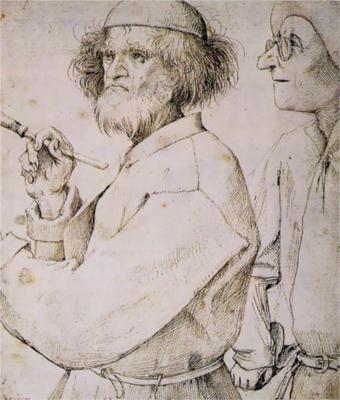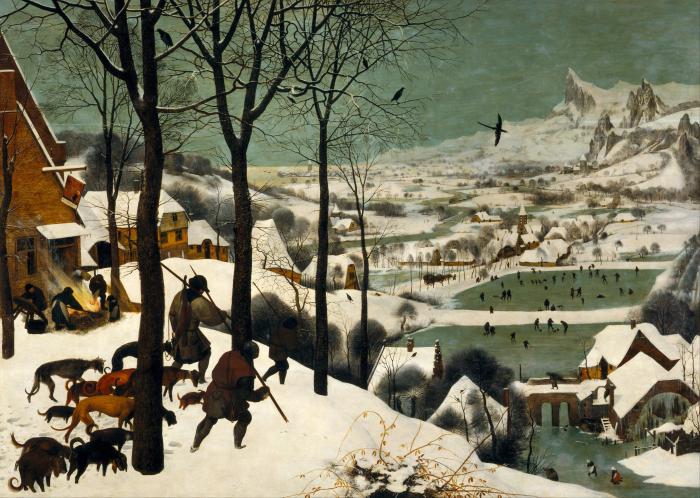This man was unhappy with the policies of the authorities and the permissiveness of the church, but he was silent all his life. His paintings spoke for him. After him there were no written documents, but the school of painting he had created remained. He created his masterpieces and forged strangers. The name of one of the most mysterious artists of the past is Peter Brueghel the Elder.
A genius about which almost nothing is known
Even the exact date of his birth is unknown. Only fragmentary information has survived to this day that a child was born in the Dutch province of Breda in 1525, who was destined to enter the history of world painting under the name Peter Bruegel the Elder. However, he will also have a nickname - "Muzhitsky." His whole life was confined to three documents that reached us. These are records of Brueghel's admission to the Guild of painters of the city of Antwerp, of registration of marriage and summarizing the record of death and burial.

That's all. The greatest artist of his time, he left no self-portrait, no portraits of his wife and children. There is reason to believe that in some of his paintings the painter depicted himself, giving individual characters their own characteristics. However, the paintings of Brueghel the Elder keep their secret. It remains, however, his portraits engraved by contemporaries, but they are devoid of similarity between themselves, and therefore not convincing.
It all started with graphics
But not everything is hidden from us by time. It is known that at the beginning of his journey Bruegel was engaged in graphics. He was taught this art by a court painter, then recognized master Peter Cook van Aalst. It was a great success for the young man to get into the workshop of such a venerable master. His talent developed rapidly, and soon he already got a profitable job from the engraving publisher Hieronymus Kok.
Further, his life path is finally determined - he is a professional artist. Gradually, the young artist becomes closely within the framework of graphics, and he begins to try his hand at painting.
Joining the Artists Guild
The paintings of Bruegel the Elder opened the way for him to the Guild of Artists. The event is very important, since without official status it was impossible to count on receiving profitable orders, and in the future - places at the yard.
Joining the guild, Peter Brueghel the Elder first saw the paintings of his great predecessor, Jerome Bosch. They shocked his imagination. Having sufficiently mastered technical skills by that time, he created a series of canvases made in the manner of his idol. For an inexperienced look, the paintings of Brueghel the Elder were not much different from the paintings of Bosch.
Signature paintings
And then there was an unpleasant incident. The fact is that vanity has always been one of human vices, and some customers bought paintings from Brueghel on condition that he put on them not his signature, but the signature of some eminent master. The young artist fulfilled their requests. But once there was a scandal: an engraving on the plot of one of his paintings was sold with the signature of Jerome Bosch as an original, for a lot of money. With incredible difficulty, we managed to avoid serious troubles.
A trip to Italy and the choice of a creative path
When Brueghel turned 25 years old, he traveled to Italy. I must say that this country has always been a kind of Mecca for artists. After three hundred years, Karl Bryullov will write that the very air of Italy is full of inspiration. Here the young painter saw landscapes that later came to life on his canvases. On his return from the trip, he lived in Antwerp, and then in Brussels.
By this time, the artist Bruegel the Elder was already quite defined as a creative personality. The fact is that in the middle of the 16th century the painting of the Netherlands was dominated by the direction of “novelists”, that is, artists who laid the foundation for their work in the style of Italian mannerism. Unlike his compatriots, he remained faithful to the traditions of the Old Dutch school.
Symbolism in the work of the artist
The work of Brueghel the Elder combines elements of reality and fantasy. Like many advanced people of his time, he was dissatisfied with the arbitrariness of the authorities and the church in the country, but was silent, since everyone who dared to raise his voice risked being at the stake. Sentences were handed down immediately. His contemporaries considered him "dumb." But the artist has his own weapon - appeal to people through the symbols embedded in his paintings. These were a kind of encrypted message. The paintings of Bruegel the Elder are “Aesopian language” in painting. Not everyone understood their meaning, but for those to whom they were intended, this language was more eloquent than words.

Peter Bruegel the Elder ended his life on September 15, 1569, reaching unprecedented heights of creativity and influencing the development of all subsequent world painting. His ashes found eternal rest in the Church of the Virgin in Brussels. He was one of the first to show the life of ordinary people on his canvases and for this he began to be called a “peasant” artist. The article contains 4 reproductions from his paintings: “The Artist and the Expert” (perhaps she conveys the portrait features of the author), “Tower of Babel”, “Peasant Wedding” and “The Return of the Hunters”.